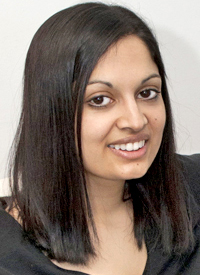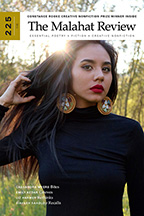How We Limn the Body:
John Barton in Conversation with
Shashi Bhat

In "Food for Nought," which appears in The Malahat Review's Summer 2017 issue, Shashi Bhat recounts the story of Nina, a high-school teacher who jumps to the wrong conclusion about the motivation behind a poem a student submits to her creative-writing class. Shashi is the editor of Event and teaches creative writing at Douglas College. Her stories have appeared in PRISM international, Journey Prize Stories 24,The New Quarterly, Grain, and other publications. Her novel, The Family Took Shape, was shortlisted for the Thomas Raddall Atlantic Fiction Award. She lives in New Westminster. Interview conducted by Malahat editor, John Barton.
At the close of "Food for Nought," Nina, a high-school English teacher and the story's often droll narrator, reveals that she will eventually leave teaching because "it feels like a job for somebody both more and less human than I am." What is it about her that makes her feel unequal to the job?
By the end of the story, Nina regrets her glibness, and realizes her teaching approach lacked empathy. She's uncomfortable having this much responsibility over vulnerable and mercurial teenagers, and as a result, she approaches the class in a shallow and cautious way. I imagine she's only been teaching a couple of years, and is thinking about what the students are thinking about her, instead of thinking deeply about the workshop poem they're discussing. She's not engaging in the discussion so much as she's trying to get through the class period without making a mistake.
I've taught creative nonfiction classes where students write about personal, traumatic experiences—death, illness, abuse—and, at the start of the semester, I tell them that our critique will focus on technique. Ultimately, though, when someone turns in a piece of paper with their own bloody heart stapled to it, you can't just sit at the front of the room and talk about scene chronology and image systems. The fact that creative-writing workshops involve recognizing the humanity of the other people in the room is one of the things I like best about teaching (I teach college students; I imagine high school requires a whole other level of personal involvement).
The story turns on an irony that results from Nina violating one of the rules we're all taught as novice writers: she assumes that a poem about having an eating disorder, which Jessica, a student in her Grade 10 English class hands in, is autobiographical. That she makes this mistake, even though she should be a seasoned teacher of creative writing, is as much amusing at it is poignant. What makes Nina so conflicted, both prior to and after deciding to report Jessica to the school guidance counsellor? What does her misinterpretation of Jessica's poem say about how we read poems and stories as well as about how we shoulder our responsibilities toward one another as people?
Part of the fun of taking a workshop class is getting these windows into the lives of your classmates. In a fiction workshop, it's not rare for a reader to wonder, hmm, how fictionalis this? Hopefully they'll also be intrigued by the writer's painstakingly crafted periodic sentences or what have you, but the life of the author can be pretty juicy to think about.
Nina indulges in speculating on the lives of her students, and her mistakes stem from wanting too badly to be liked. She uses the fact that it's "creative writing" to avoid taking action, and perhaps isn't quite prepared to accept that she's the adult in the room.
Nina's classroom life is counterpointed by her personal life, with food linking the story's two narrative threads. We first meet her parents, immigrants from India, when Nina visits her father in hospital. Even though on the surface it looks as if he eats a healthy South Indian vegetarian diet, his doctors have advised him that he must modify it substantially in the aftermath of heart surgery. Even though he and Nina's mother may find the introduction of eggs and salmon into his diet bewildering, he's making these changes based on "evidence." Would Nina ultimately stay in her job if it were—for a lack of a better description—more "evidence-based"? Why didn't it occur to her to ask Jessica if her poem was a call for help?
Nina might have an easier time as a math teacher. It would allow her to operate at a safer distance. I also think that if she'd channelled her sensitivity in a better way, and stayed in her job, she would have grown into it. With a previous student in the story, she tries a more direct approach, writing a note on the student's assignment. Later she receives an anonymous evaluation telling her to "mind her own goddamned business." She's scared off by it.
In the story you contrast two ways of understanding the world: inference (which reading and writing demand of us) and analysis (upon which science and medicine rely). You present both approaches comically, but "Food for Nought" seems to take more of a stand on the pratfalls of operating wholly on the basis of assumption. Do you feel relying on "facts" equally compromises us? Are Nina's parents compromised by their reliance on them?
Nina's bewildered parents are navigating health recommendations from a doctor who hasn't considered their culture or tried to understand where they're coming from. Nina's parents are making what they believe is a necessary sacrifice. Her father has been a pious Hindu vegan his whole life and compromises on his religious beliefs because he and his wife are so afraid that they just follow whatever advice the doctor gives them. (If I knew them, I might suggest they get a nutritionist to give them ideas for how to eat a heart healthy vegan diet…)
With the poems, Nina makes an obvious assumption without considering other options. I hadn't thought explicitly about inference vs. analysis while writing this story, but the life-and-death decisions the characters make would benefit from a balance of both.
At Jessica's suggestion, Nina's students make a "plaster woman," a composite assembled from casts they make off one another, each student, even the two boys in class (but not Nina), contributing a body part. The sampled hands, limbs, breasts, stomachs, mouth and forehead, etc., are wired together, painted, and decorated with lines of their own poetry written in glitter. What does the sculpture suggest about how we conceive of body image? Why is it significant that it remains on display in the school's hallways for years?
The intended "message" of the students' sculpture might be "Let's all love and accept ourselves," but while applying plaster on themselves they compare the flatness of their stomachs. Even Nina feels self-conscious about eating her carb-only sandwich, and when confronted with actual student bodies (no pun intended), she's uncomfortable to the extent that she leaves the classroom. I hoped to reflect this by making the plaster woman grotesque, fetishized, and hollow. It's also unexpectedly permanent, like the choices made in the story.
The plaster woman reminded me of the cake that Marian MacAlpin makes and offers to her boyfriend in The Edible Woman, a novel that Margaret Atwood published in 1969. No matter how far we have or haven't come in understanding women's (and men's) bodies, what is it about them that inspires such discourse? Why does it make Nina so unsettled?
That's a favourite Atwood scene of mine, so I'm flattered by this comparison! The thing I ruminate about is the inability to control one's body—Nina's father's diet resembles Gandhi's but does not prevent a heart attack, and Nur can't control the consequences of her mental health disorder on her physical health.
Full disclosure: In high school I took a Women in Literature class taught by a burly bearded man who developed a dislike for me after I corrected him when he said Dragons of Eden was written by Isaac Asimov. (Now I realize how obnoxious I must have seemed.) Coincidentally, we read The Handmaid's Tale in that class. A group of my classmates made a plaster woman like the one in the story. As a self-conscious, overweight teen, this scared the hell out of me. I was intimidated by the girls who were bold enough to model their waists for independent study projects (and of course, I also wanted to be them, because it was high school). Nina is not overtly body conscious, but she's aware of the complicated body relationships that exist in that classroom.
As I mentioned earlier, "Food for Nought" is often very funny. Other than Lena Dunham or Margaret Cho, I can't think of many recent writers or performers who've approached our perceptions of eating disorders as mordantly, or with such a light touch that never undermines the gravitas. Most of what's out there on this topic is overwhelmingly serious. Why has humour been such a good strategy for you?
I wrote the first draft of this story almost a decade ago, for a reading series my grad-school peers and I performed at a bar in Baltimore. The audience was mostly our nineteen or twenty-year-old pre-med students. I was aiming to write something entertaining to them—funny, a little taboo, bits of science, lots of twists. Admittedly, the first draft was melodramatic and cheaply sensational. But I like this idea of making the reader laugh and then feel guilty for laughing. And humour and pathos are so much fun to combine—I like the challenge of getting the timing right. Some of my favourite inspirations for this are ZZ Packer's excellent short story collection, Drinking Coffee Elsewhere, and Lorrie Moore's eternally surprising story, "People Like That Are the Only People Here." I like the way this style allows the writer to sneak up on the reader with an unexpectedly poignant ending, to create a dramatic emotional range within only a few thousand words, and to address "heavy" topics without weighing down a piece with self-seriousness. In this particular story I think it allowed me to write a character who makes pretty big mistakes but is still (as my students would say) "relatable" and likeable enough that the reader can forgive her.

John Barton
* * * * * * * *









